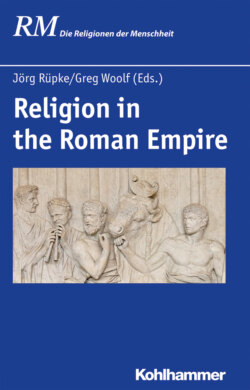Читать книгу Religion in the Roman Empire - Группа авторов - Страница 31
На сайте Литреса книга снята с продажи.
2.2 Villages, towns and regions: spatial-religious references and regional traditions in sanctuaries
ОглавлениеIt can be assumed that about 95% of the people in the Roman Empire lived in the countryside, many of them in villages, daily occupied by farming and livestock breeding.88 But these people often appear less clearly in archaeological or textual sources than the inhabitants of urban habitats,89 such as poleis, oppida, municipia, coloniae, who formed the socio-political and administrative cores of the Roman Empire and its bureaucracy.90
Since Rome itself was a city-state, and also in its new territories in Italy, Greece, the former Carthaginian territories in Africa, Hispania, and Gallia urban social organisations were common, the question arises how the socio-political and socio-religious changes, how the representation of power functioned in areas that were differently and less urbanised, such as the Celto-Germanic regions of Gallia, Hispania and Germania, later also Britannia, Noricum and Dacia, or areas far away from the cities, as the countless rural regions for example in North Africa, Asia Minor, or Syria.
The religious needs of rural people were no less pronounced than those of urban dwellers. The areas of life that absolutely needed divine protection were mainly about vital resources (crops, water and appropriate climate) and social order among closer and more distant neighbours. Therefore, there was a plethora of local sanctuaries in the Mediterranean region—not only in Roman times—with a small catchment area and no supra-regional significance, at least in most phases of their history. The sanctuary of San Giovanni in Galdo, located in Samnium, is such a place where the surrounding population gathered for festivities.91 In Attica or the Anatolian region Phrygia, for example, a considerably large number of small sanctuaries is documented, often only by inscriptions and not in architectural remains,92 whose catchment area included the surrounding villages. Yet, we cannot assume a strong dichotomy of rural and urban lifestyles in all provinces of the Roman Empire. The settlement pattern in Hauran (southern Syria/northern Jordan), as we know it from the 1st century B.C. to the 5th century A.D., is characterised by a large number of rather small settlements, some only 2 km apart, which were closely linked by religious institutions such as buildings, deities, festivals and the persons responsible for them.93 Even if there were poleis—settlements with the status of a city like for example Bostra or Dionysias/Suweida—each smaller settlement also had temple buildings;94 in addition, sacred precincts could also be found between the settlements.95 The people who used these local sanctuaries did not do so less intensively than was the case in large sanctuaries with supra-regional significance. Religious practices and participation in the religious life of a community was to be equated with social togetherness in general, and at the same time closely linked with economic institutions such as markets and the like.96 Especially epigraphic evidence from some of the ancient villages in Asia Minor provide information about this,97 as does the sanctuary of Baitokaike/Hosn es-Suleiman in Syria.98 The local influence that such places, their operators, users and visitors had was great and to some extent independent of the Roman administration.99
Varying distances from and varying significance for the city of Rome determined which people came to the santuaries, which traditions were kept or how they were transformed. Depending on whether they were locally important sanctuaries, whether they were located in or near militarily equipped cities, whether veterans were settled, or many merchants passed by, shaped the buildings, the practices, the (image-)objects in a sanctuary, and visitor numbers would also differ. As the provincial capital of Syria and seat of a legion from Cyrenaica, Bostra, for example, housed a temple for a genuinely North African god—Zeus Ammon.100
In the architecture of temple buildings and sanctuaries the overlays caused by the different architectural and religious traditions can be determined. In cities in North Africa, such as Thugga, where a temple on a podium for Saturn was erected on the forum, people took over new types of religious buildings, while at the same time the areas of stelae (tophets) were still in use or revived.101 In the provinces of Syria and Arabia local, West Asian and Mesopotamian elements were used in the formation of ritual facilities, either architecturally framed ones or in the open, such as altars, platforms, courtyards, banqueting rooms or high places.102 In Roman times, commissioners of religious buildings often referred to plans and designs perceived of as »old«, so that new forms were created with formal and functional links to former architectural layouts again an attempt to underline the antiquity of the practised cults through reinventing religious traditions.103
Furthermore seasonality would have played a role in religion but remains an understudied area within archaeological research.104 The shifting seasons were the basis for the structure of economic, but therefore also religious life. Certain cults could and were only celebrated at certain points of the year. Where markets were connected with religious festivals, these would certainly have been given preferences as to what suited the harvest for certain crops and production circles—not everything was decided by the religious traditions, but religious traditions could be shaped around the human needs and circumstances. The interaction between the gods and the humans was directed pragmatically by life circumstances.
What has been described for many years by the concept of Romanisation is a grand narrative suitable for perspectives on large scales, which—to be better understood—must be tracked down in local, individual cases. Since processes of contact and exchange often crystallise in identity-forming, religious practices of groups of individuals in local conditions, these processes are among other places lived and negotiated at sacred places. By the continuous actitivites of people simultaneously worshipping and communicating with a multitude of deities in countless ways, self-positioning in always changing circumstances was re-assured,105 Hence, the lived religion plays a crucial role in grasping the interplay of known, new, re-appropriated socio-cultural and socio-political traditions.106
